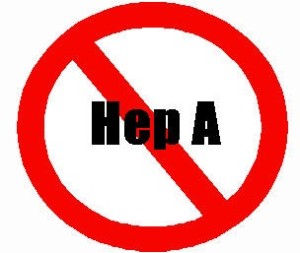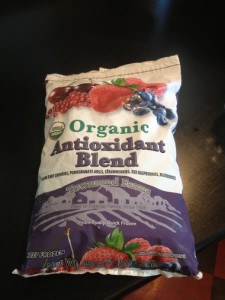
- are 75 years old or older
- are immune-compromised
- have chronic liver disease or have had a liver transplant
- have clotting-factor disorders
- are experiencing hepatitis A symptoms


The objectives of this study were to determine whether fecal shedding of non-O157 Shiga toxin–producing Escherichia coli (STEC) in feedlot cattle was affected by the use of an E. coli O157:H7 vaccine or a direct-fed microbial (DFM) and whether the shedding of a particular non-O157 STEC serogroup within feces was associated with shedding of O157 or other non-O157 STEC serogroups. A total of 17,148 cattle in 40 pens were  randomized to receive one, both, or neither (control) of the two interventions: a vaccine based on the siderophore receptor and porin proteins (E. coli SRP vaccine, two doses) and a DFM product (low-dose Bovamine). Fresh fecal samples (30 samples per pen) were collected weekly from pen floors for four consecutive weeks beginning approximately 56 days after study allocation. DNA extracted from enriched samples was tested for STEC O157 and non-O157 serogroups O26, O45, O103, O111, O121, and O145 and for four major virulence genes (stx 1, stx 2, eae, and ehxA) using an 11-gene multiplex PCR assay. Generalized linear mixed models were used to analyze the effects of treatments and make within-sample comparisons of the presence of O-serogroup–specific genes. Results of cumulative prevalence measures indicated that O157 (14.6%), O26 (10.5%), and O103 (10.3%) were the most prevalent STEC O serogroups. However, the vaccine, DFM, or both had no significant effect (P > 0.05) on fecal prevalence of the six non-O157 STEC serogroups in feedlot cattle. Within-sample comparisons of the presence of STEC serogroup–specific genes indicated that fecal shedding of E. coli O157 in cattle was associated with an increased probability (P < 0.05) of fecal shedding of STEC O26, O45, O103, and O121. Our study revealed that neither the E. coli O157:H7 vaccine, which reduced STEC O157 fecal shedding, nor the DFM significantly affected fecal shedding of non-O157 STEC serogroups, despite the fact that the most prevalent non-O157 STEC serogroups tended to occur concurrently with O157 STEC strains within fecal samples.
randomized to receive one, both, or neither (control) of the two interventions: a vaccine based on the siderophore receptor and porin proteins (E. coli SRP vaccine, two doses) and a DFM product (low-dose Bovamine). Fresh fecal samples (30 samples per pen) were collected weekly from pen floors for four consecutive weeks beginning approximately 56 days after study allocation. DNA extracted from enriched samples was tested for STEC O157 and non-O157 serogroups O26, O45, O103, O111, O121, and O145 and for four major virulence genes (stx 1, stx 2, eae, and ehxA) using an 11-gene multiplex PCR assay. Generalized linear mixed models were used to analyze the effects of treatments and make within-sample comparisons of the presence of O-serogroup–specific genes. Results of cumulative prevalence measures indicated that O157 (14.6%), O26 (10.5%), and O103 (10.3%) were the most prevalent STEC O serogroups. However, the vaccine, DFM, or both had no significant effect (P > 0.05) on fecal prevalence of the six non-O157 STEC serogroups in feedlot cattle. Within-sample comparisons of the presence of STEC serogroup–specific genes indicated that fecal shedding of E. coli O157 in cattle was associated with an increased probability (P < 0.05) of fecal shedding of STEC O26, O45, O103, and O121. Our study revealed that neither the E. coli O157:H7 vaccine, which reduced STEC O157 fecal shedding, nor the DFM significantly affected fecal shedding of non-O157 STEC serogroups, despite the fact that the most prevalent non-O157 STEC serogroups tended to occur concurrently with O157 STEC strains within fecal samples.
Journal of Food Protection®, Number 5, May 2014, pp. 696-863 , pp. 732-737(6)
Cernicchiaro, N.1; Renter, D. G.2; Cull, C. A.1; Paddock, Z. D.1; Shi, X.1; Nagaraja, T. G.1
JoNel Aleccia of NBC News writes the question of whether hepatitis A inoculations should be mandatory for food workers — or whether the cost to business isn’t worth the wider benefit — is gaining renewed attention from federal regulators, health officials and ordinary consumers amid a spate of new restaurant warnings.
 As many as 17,000 people a year are sickened by hepatitis A, according to 2010 estimates from the Centers for Disease Control and Prevention, and about 95 people die. That’s only a fraction of the 48 million people in the U.S. who are sickened by food poisoning each year, but hepatitis A is the only foodborne bug for which an effective vaccine actually exists.
As many as 17,000 people a year are sickened by hepatitis A, according to 2010 estimates from the Centers for Disease Control and Prevention, and about 95 people die. That’s only a fraction of the 48 million people in the U.S. who are sickened by food poisoning each year, but hepatitis A is the only foodborne bug for which an effective vaccine actually exists.
The hepatitis A virus causes acute liver infection that can trigger lingering illness and even liver failure or death, though that’s rare. It’s spread when a person ingests fecal material from an infected person and causes symptoms that include, fever, chills, nausea, dark-colored urine and jaundice, a yellowing of the skin or eyes.
In 2006, experts began recommending universal hepatitis A vaccines for kids starting at age 1, changing the pool of potential infections.
“There was a very rapid transition in the U.S. over the last half decade,” Murphy said. “We have this gap of adults who are not protected in their 20s, 30s, 40s and 50s.”
In other words, the people most vulnerable to hepatitis A are those most likely to work — and eat — in restaurants.
Bill Marler, a Seattle food safety lawyer has lobbied for mandatory vaccination for food handlers since a hepatitis A outbreak tied to two Subway sandwich shops sickened 40 people in 1999.
“It was a horrible outbreak. We represented a bunch of people including a little boy who lost his liver at 8 years old and required a transplant,” he said.
But restaurant industry officials — and some health officials — note that such outbreaks and consequences, though regrettable, are rare.
The Fargo, North Dakota, Catholic Diocese’s new bishop may have exposed hundreds of church members here and in Jamestown to the hepatitis A virus in late September and early October.
“The risk of people getting hepatitis A in this situation is low, but the Department of Health felt it was important for people to know about  the possible exposure,” said Molly Howell, immunization program manager.
the possible exposure,” said Molly Howell, immunization program manager.
The diocese announced Monday that Bishop John Folda is taking some time off after being diagnosed with hepatitis A. The diocese said he contracted the infection through contaminated food while attending a conference for newly ordained bishops in Italy last month.
In New York City, a Hepatitis A outbreak at a Westchester Square pizzeria, has its neighboring eateries dealing with the side effects.
The New York Daily News reported that several eateries near the still-shuttered New Hawaii Sea restaurant which closed last month after five patrons caught Hepatitis A, say they’re stuck dealing with the stigma of the virus.
Ljubo Kocovic, who opened his own pizzeria 28 years ago in 1985, said because of the Hepatitis scare, business has suffered.
“This is the slowest it has ever been. I’ve never seen an October like this,” Kocovic said. “One guy has a problem, and we all suffer. It’s very stressful.”
Restaurant owner, Nilesh Patel of M&R Coffee Shop agreed.
“People are afraid to come,” he said. “It’s not fair. They made a mistake, they should have to pay the price.”
Cattle are the primary reservoir for E. coli O157. The vaccines that are available for cattle are rarely used, but the latest study suggests the public health benefits could be significant.
The research was lead by a team of researchers at the University of Glasgow in collaboration with the University of Edinburgh, the Royal  Veterinary College, Scotland’s Rural College, Health Protection Scotland, and the Scottish E. coli O157/VTEC Reference Laboratory.
Veterinary College, Scotland’s Rural College, Health Protection Scotland, and the Scottish E. coli O157/VTEC Reference Laboratory.
The study, published in the online journal PNAS, used veterinary, human and molecular data to examine the risks of E. coli O157 transmission from cattle to humans, and to estimate the impact of vaccinating cattle.
The risk of E. coli O157 infection is particularly significant when the cattle are ‘super-shedding’ – excreting extremely high numbers of bacteria in their faeces for a limited period of time. Vaccines against the bacteria exist that can reduce super-shedding.
As a consequence, the researchers predict that vaccinating cattle could reduce human cases by nearly 85 percent, far higher than the 50 percent predicted by studies simply looking at the efficacy of current vaccines in cattle.
Whenever I buy a house in some new town, the first thing I do is plant berries. Strawberries, raspberries, blackberries, even got some loganberries in Brisbane. They take a couple of years to come in to full production, but after that, easy peasy.
My grandfather had maybe a 30-foot-by-10-food patch of raspberries on his  front yard, and that produced an endless supply. Guess I got hooked.
front yard, and that produced an endless supply. Guess I got hooked.
So it’s more than disconcerting that the multistate outbreak of Hepatitis A linked to frozen berries continues to spread, with 79 people now confirmed as sick.
The U.S. Centers for Disease Control reports that based on epidemiologic investigation of 55 cases:
• 35 (64%) ill people are women;
• ages range from 2 – 84 years;
• illness onset dates range from 3/16/2013 – 6/1/2013
• 30 (55%) ill people have been hospitalized, and no deaths have been reported;
• 40 (73%) of 55 ill people interviewed reported eating “Townsend Farms Organic Antioxidant Blend” frozen berry and pomegranate mix; and,
• 40 persons reported purchasing this product from Costco markets; however, the product was also sold at Harris Teeter stores. No cases have been
 identified that bought the product at Harris Teeter at this time.
identified that bought the product at Harris Teeter at this time.
Preliminary laboratory studies of specimens from two states suggest the outbreak strain of hepatitis A virus (HAV) is genotype 1B. This strain is rarely seen in the Americas but circulates in the North Africa and Middle East regions.
This genotype was identified in a 2013 outbreak in Europe linked to frozen berries and another 2012 outbreak in British Columbia related to a frozen berry blend with pomegranate seeds from Egypt. However, there is no evidence at this time that these outbreaks are related.
According to the label, the “Townsend Farms Organic Antioxidant Blend” frozen berry and pomegranate mix associated with illness contained products originating from the U.S., Argentina, Chile, and Turkey.
To their credit, Costco is offering to refund the cost of hepatitis A vaccinations or provide the vaccination free of charge at a Costco pharmacy to customers who consumed the recalled frozen berries.
Craig Wilson, Costco’s vice president of quality insurance, food safety and merchandise services, said the company used membership records and receipts to contact customers who purchased the recalled berries since February.
“If anyone has a concern, they should get to their personal health care provider,” Wilson said.
Wilson said he could not confirm that 100 percent of purchasers of the product were contacted, but the company made multiple attempts to inform  members of the recall and the potential need for vaccinations.
members of the recall and the potential need for vaccinations.
“Wednesday afternoon I sent out another message to 250,000 folks to remind them about the recall,” he said.
Bill Marler, a Seattle-based lawyer, recently filed a class-action lawsuit against Townsend Farms in California. He said his office has been contacted by approximately 400 people who received vaccinations as a result of purchasing the frozen berries, and only about half of those were contacted by Costco.
Elizabeth Weise of USA Today noted the outbreak has seemingly spared children, probably because of routine vaccinations against hepatitis A since 2006.
“The very, very small number of children involved in this outbreak probably reflects the high vaccination coverage as the result of the routine immunization,” said John Ward, who directs the viral hepatitis program at CDC.
The one child who did become ill, a 2-year-old, was not vaccinated, Ward said.
The hepatitis A vaccine is given to children twice, first between 6 and 12 months and then six months later, said CDC’s Trudy Murphy, a hepatitis expert. The vaccine became available in 1996. In 2006 CDC recommended that all children be vaccinated against the virus.
Sorenne’s got that vaccine. So do me and Amy.
Widespread vaccination is having an impact. In 1995 there were 31,582 hepatitis A cases in the United States. In 2010, the most recent year for which numbers are available, there were 1,670, according to CDC.
Health officials vaccinated hundreds of people against hepatitis A Saturday during a free drive-thru clinic organized after a worker at a local restaurant tested positive for the highly contagious virus.
Anyone who ate or drank at 800 Degrees Three Fires restaurant on Illinois Road between May 18 and May 26 was urged to receive the vaccine as a precaution. Aside from the worker, no other cases have been detected, said  John Silcox, a spokesman for the Fort Wayne-Allen County Health Department.
John Silcox, a spokesman for the Fort Wayne-Allen County Health Department.
On Saturday afternoon, dozens of cars slowly snaked through a parking lot to one of three stations where vaccinations were given. After filling out the necessary paperwork, drivers and passengers received a single shot to the arm while sitting in their cars.
During the busiest times, the wait peaked at close to an hour, Silcox said.
“We’ve definitely seen quite a bit of traffic,” he said. “We do ask for people to be patient with us and understanding.”
Mona Dewart, 58, said she waited about 45 minutes for a shot, passing the time reading a newspaper and playing games on her cellphone. The errand was an inconvenience, but for her it was better than potentially falling ill.
“I’m surprised that they had such a service like this,” she said of the clinic. “It certainly beats everybody scrambling to try to get into the physician’s office in the next few days.”
Fifty to 75 Health Department employees and volunteers helped with the clinic, Silcox said, adding that it was too early to estimate the cost of the effort.
He said 581 vaccinations had been administered by 5:30 p.m., and the clinic was scheduled to stay open until 8 p.m. Health officials have said they expect to vaccinate a total of 1,000 to 1,200 people this weekend.
A commercial vaccine for cattle can effectively reduce levels of E. coli by more than 50 percent, a Kansas State University study has found. The vaccine is also effective using two doses instead of the recommended three doses, which can help cut costs for the beef industry.
David Renter, associate professor of epidemiology, is the principal investigator on a project that researched the effectiveness of products used to prevent the shedding of E. coli O157:H7 in cattle. The research appears in a recent online version of the journal Vaccine and helps improve current preventative methods for addressing food safety concerns.
While E. coli O157:H7 does not affect cattle, it causes foodborne disease in humans. Vaccines and other products may be given to cattle to help prevent the spread of the bacteria.
"We wanted to test how well these products work to control E. coli O157:H7 in a commercial feedlot with a large population of cattle that were fed in the summer and may be expected to  have a high level of E. coli O157:H7," Renter said.
have a high level of E. coli O157:H7," Renter said.
Other Kansas State University researchers involved include T.G. Nagaraja, university distinguished professor of microbiology; Nora Bello, assistant professor of statistics; Charley Cull, doctoral student in pathobiology, Oakland, Neb.; and Zachary Paddock, doctoral student in pathobiology, Manhattan. Abram Babcock, an August 2010 Kansas State University doctoral graduate, also was involved in the research.
Using a commercial feedlot setting, the researchers studied more than 17,000 cattle during an 85-day period. They studied two products: a vaccine and a low-dose direct-fed microbial.
"What’s unique about this study is the number of animals we used, the research setting and that we used commercial products in the way that any cattle producer could use them," Renter said. "We didn’t want it to be any different than the way somebody would use the products in a commercial feedlot."
The researchers found that the vaccine reduced the number of cattle that were shedding E. coli O157:H7 in feces by more than 50 percent. E. coli shedding was reduced by more than 75 percent among cattle that were high shedders of E. coli. While the vaccine label suggests that it is given in three doses, the researchers found that two doses of the vaccine significantly reduced E. coli.
"Showing that level of efficacy with two doses is really important because a shift to two doses from three could significantly cut costs for the beef industry," Renter said. "In terms of logistics, it can be difficult for commercial feedlot production systems to vaccinate animals three times. Both of these benefits help when considering how the vaccine can be adopted and implemented in the industry."
The researchers also discovered that the low-dose direct-fed microbial product did not work as well as the vaccine. Renter said while the study used a lower dose of the direct-fed microbial and could find no evidence that it reduced E. coli shredding, it is possible that the direct-fed microbial product is more effective at a higher dose.
"This vaccine is an option for reducing E. coli," Renter said. "We have shown that this vaccine works and that it is a tool that could be adopted in the industry."
The research was supported as part of a three-year $1 million grant from the U.S. Department of Agriculture. Nagaraja and Renter are involved in several other studies on E. coli O157 and other types of E. coli closely related to O157, including research associated with the $25 million coordinated agricultural program, or CAP, grant with the University of Nebraska Lincoln and several other universities. That five-year grant is supported by the USDA’s National Institute of Food and Agriculture.
Abstract below:
Efficacy of a vaccine and a direct-fed microbial against fecal shedding of Escherichia coli O157:H7 in a randomized pen-level field trial of commercial feedlot cattle.
13.jun.12
Vaccine
Cull CA, Paddock ZD, Nagaraja TG, Bello NM, Babcock AH, Renter DG
http://www.ncbi.nlm.nih.gov/pubmed/22704925
Abstract
Our primary objective was to determine the efficacy of a siderophore receptor and porin proteins-based vaccine (VAC) and a Lactobacillus acidophilus-based direct-fed microbial (DFM) against fecal shedding of Escherichia coli O157:H7 in commercial feedlot cattle fed a corn grain-based diet with 25% distiller’s grains. Cattle projected to be on a finishing diet during the summer were randomly allocated into 40 study pens within ten blocks based on allocation dates. Blocks were complete; each of the four pens within a block was randomly assigned one treatment: control, VAC, DFM, or VAC+DFM. The DFM was fed (10(6)CFU/animal/day of Lactobacillus) throughout the study periods (84-88 days) and cattle were vaccinated at enrollment and again three weeks later. Fresh fecal samples (30/pen) from pen floors were collected weekly for four consecutive weeks (study days 52-77). Two concurrent culture procedures were used to enable estimates of E. coli O157:H7 shedding prevalence and prevalence of high shedders. From 4800 total samples, 1522 (31.7%) were positive for E. coli O157:H7 and 169 (3.5%) were considered high shedders. Pen-level linear mixed models were used for data analyses. There were no significant interactions among treatments and time of sampling. However, vaccinated pens had lower (P<0.01) overall prevalence of E. coli O157:H7 (model-adjusted mean ±SEM=17.4±3.95%) and lower (P<0.01) prevalence of high shedders (0.95±0.26%) than unvaccinated pens (37.0±6.32% and 4.19±0.81%, respectively). There was no evidence of a DFM effect on either measure of E. coli O157:H7 shedding. Results indicate that a two-dose regimen of the vaccine significantly reduces fecal prevalence of E. coli O157:H7 (vaccine efficacy of 53.0%) and prevalence of E. coli O157:H7 high shedders (vaccine efficacy of 77.3%) in commercial feedlot cattle reared in the summer on a finishing diet with 25% distiller’s grains.
A vaccine could be developed to prevent Campylobacter being carried in chickens according to an American scientist presenting his work at the Society for General Microbiology’s Spring Conference in Dublin.
Foodborne illness costs the UK an estimated £2 billion each year. Campylobacter is the leading cause of foodborne illness and is responsible for about 30% of cases in the UK. Campylobacter jejuni was  responsible for more than 371,000 estimated cases in England and Wales in 2009, resulting in more than 17,500 hospitalizations and 88 deaths.
responsible for more than 371,000 estimated cases in England and Wales in 2009, resulting in more than 17,500 hospitalizations and 88 deaths.
Scientists at Washington State University are studying the maternal antibodies that are passed from hens to their chicks. "These antibodies protect chicks from becoming colonized by Campylobacter in the first week of life," explained Professor Michael Konkel who is leading the research. "Our group has now identified the bacterial molecules that these antibodies attack, which has given us a starting point for a vaccine against Campylobacter," he said. "We have already found that chickens injected with these specific molecules – found on the surface of Campylobacter jejuni – produce antibodies against the bacterium. This response partially protects them from colonization."
"Preventing contamination of poultry at slaughter has not been effective at reducing illness in humans. It has been shown that about 65% of chickens on retail sale in the UK are contaminated with Campylobacter," explained Professor Konkel. "Ideally, the best way to prevent contamination is to stop chickens on the farm from becoming colonized with this microorganism in the first place, which could be achieved by vaccination. Our goal within the next 6 months is to test a vaccine for chickens that will reduce Campylobacter colonization levels. There’s still a long way to go, but I’m confident our lab and others are moving in the right direction."
A new report concludes the federal government should provide more specific public guidance on the license approval requirements of vaccines that could reduce the incidence of E. coli O157:H7 and friends in cattle.
Because right now, it’s bureaucratic, and no one can offer a clear explanation.
The U.S Government Accountability Project in report GAO-12-257 (for sticklers) also concluded the Secretary of Agriculture should explore practices employed by other countries that are not currently used in the U.S. for reducing shiga-toxin producing E. coli (STEC) in cattle and consider whether the identified practices can inform U.S. efforts.
From the report:
U.S. Department of Agriculture (USDA) and university researchers identified several treatments administered before cattle are slaughtered, or preslaughter interventions, that could reduce Shiga toxin-producing Escherichia coli (STEC) in cattle. Such preslaughter interventions include .jpg) bacteriophages (viruses that infect and kill bacteria), probiotics (live bacteria that can benefit the digestive system), vaccines (biological preparations that alter the immune system), and sodium chlorate (chemical that kills the STEC O157:H7 strain). However, few manufacturers have submitted applications for preslaughter intervention products to target STEC according to officials from USDA and the Food and Drug Administration. One exception is for vaccines to reduce STEC O157:H7.
bacteriophages (viruses that infect and kill bacteria), probiotics (live bacteria that can benefit the digestive system), vaccines (biological preparations that alter the immune system), and sodium chlorate (chemical that kills the STEC O157:H7 strain). However, few manufacturers have submitted applications for preslaughter intervention products to target STEC according to officials from USDA and the Food and Drug Administration. One exception is for vaccines to reduce STEC O157:H7.
For preslaughter interventions, USDA exercises responsibilities for licensing and regulating STEC vaccines. However, USDA’s approval requirements for these vaccines are unclear, according to some industry representatives. Specifically, USDA’s general guidance does not address some of the unique challenges faced by manufacturers of animal health products seeking STEC vaccine approval. For example, the guidance does not explain that, if studies conducted in the laboratory are insufficient to demonstrate efficacy, the manufacturer would also need to demonstrate that the vaccine is effective in a field setting such as a feedlot. In contrast, the Canadian Centre for Veterinary Biologics provides more specific guidance about when it requires the use of laboratory or field studies to demonstrate efficacy for vaccine license applications. Without guidance that gives manufacturers clear and more specific information they need to submit for an acceptable application, the approval process for STEC vaccines could face potential delays.
In addition to STEC O157:H7, which it stated in 1994 was an adulterant—a substance that renders food injurious to human health—in September 2011, USDA determined that six other STEC strains were adulterants in raw ground beef and beef trim (meat left after steaks and roasts are cut from beef). USDA has tests for these six strains and plans to use them in slaughter plants starting in June 2012. However, it may be difficult and time-consuming to confirm positive test results because certain test components are either not commercially available for all strains or do not always provide clear results. USDA is working to improve the tests and to find a commercial supplier for one key test component. Also, a few companies voluntarily test for these strains.
Some foreign governments have practices that could be relevant to U.S. efforts to reduce STEC in cattle such as the following:
The European Parliament and the Council of the European Union require certain measures, such as verification of cleanliness by an inspector, to ensure that the cattle going to slaughter are clean. In contrast, USDA assesses the health of cattle but does not inspect for cleanliness.
At least 12 European Union member countries collected and reported data on STEC in live cattle in 2009. USDA has conducted STEC testing in live cattle, but has not tested since 1999.
When a person becomes ill from E. coli in Sweden, government officials try to determine the specific farm that sold the contaminated cattle so that other carcasses from the farm can be tested for STEC. USDA does not trace the STEC source back to the farm.
The complete report is available at http://www.gao.gov/products/GAO-12-257.